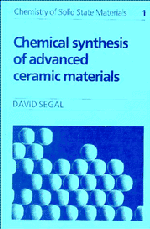Book contents
- Frontmatter
- Contents
- Preface
- Symbols
- 1 Introduction: the variety of ceramic systems
- 2 Conventional routes to ceramics
- 3 Ceramic fabrication
- 4 Sol–gel processing of colloids
- 5 Sol–gel processing of metal–organic compounds
- 6 Non-aqueous liquid-phase reactions
- 7 Polymer Pyrolysis
- 8 Hydrothermal synthesis of ceramic powders
- 9 Gas-phase reactions
- 10 Miscellaneous synthetic routes to ceramic materials
- Appendix: Determination of particle size
- References
- Index
4 - Sol–gel processing of colloids
Published online by Cambridge University Press: 04 April 2011
- Frontmatter
- Contents
- Preface
- Symbols
- 1 Introduction: the variety of ceramic systems
- 2 Conventional routes to ceramics
- 3 Ceramic fabrication
- 4 Sol–gel processing of colloids
- 5 Sol–gel processing of metal–organic compounds
- 6 Non-aqueous liquid-phase reactions
- 7 Polymer Pyrolysis
- 8 Hydrothermal synthesis of ceramic powders
- 9 Gas-phase reactions
- 10 Miscellaneous synthetic routes to ceramic materials
- Appendix: Determination of particle size
- References
- Index
Summary
Introduction
The phrase sol–gel describes several types of processes in different areas of chemistry and materials development, while the term ‘gel’ has been used (Flory, 1974) to embrace a wide range of substances in systems as diverse as lamellar mesophases, inorganic clays and oxides, phospholipids, disordered proteins and three-dimensional or network polymers. There are three types of sol–gel processes associated with corresponding transitions. Examples of the first are the reversible gelation of certain polysaccharide solutions, for example, agarose and the vulcanisation of rubber, but these transitions will not be considered in this book. The other two sol–gel processes have attracted intense interest since the mid-1970s because of their use in the synthesis of ceramic materials. Sol–gel processing of metal–organic compounds, namely, alkoxides, is described in chapter 5, while the early study of colloids, their stability and use in sol–gel transitions for both nuclear and industrial ceramics are the subject of this chapter.
The nature of colloids
The scientific study of colloids dates back to 1845 when Selmi prepared silver chloride dispersions (sols) followed by Prussian blue sols in 1847, which he referred to as demulsions and pseudosolutions, respectively. These systems were considered to be in the same category as starch, cholic acid and albumin, but distinct from true solutions, following experiments on the effect of salt on their sedimentation. Faraday (1857) observed light-scattering from ruby-coloured gold sols made by reduction of gold chloride with phosphorus together with the effect of salt on their stability and colour.
- Type
- Chapter
- Information
- Chemical Synthesis of Advanced Ceramic Materials , pp. 33 - 57Publisher: Cambridge University PressPrint publication year: 1989
- 3
- Cited by

